Sarum Dene, Salisbury, Tuesday evening, 22 August 2000
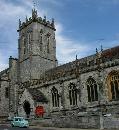
 Readers familiar with Thomas Hardy's novels, particularly The Mayor of Casterbridge, may appreciate these glimpses of Dorchester, which is thinly disguised by the name of Casterbridge in his work. Our walking tour of the Hardy sights began with St. Peter's Church and the bit of street beside it called The Bow (left), and our own hotel the King's Arms, with its bow window on what the English call the first floor and Americans call the second (right). Henchard, the novel's title character, is represented in the King's Arms on a couple of occasions in the novel (once seen through the bow window), and now the ground-floor bar is duly named Henchard's Bar.
Readers familiar with Thomas Hardy's novels, particularly The Mayor of Casterbridge, may appreciate these glimpses of Dorchester, which is thinly disguised by the name of Casterbridge in his work. Our walking tour of the Hardy sights began with St. Peter's Church and the bit of street beside it called The Bow (left), and our own hotel the King's Arms, with its bow window on what the English call the first floor and Americans call the second (right). Henchard, the novel's title character, is represented in the King's Arms on a couple of occasions in the novel (once seen through the bow window), and now the ground-floor bar is duly named Henchard's Bar.
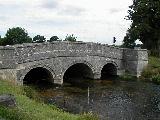
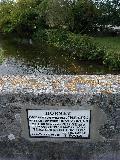
 This bridge, Grey's Bridge, also features in the same novel, and one or two others by Hardy. A character in Under the Greenwood Tree "leant over the parapet of the bridge and looked into the river. He saw . . . the long green locks of weed that lay heaving and sinking with their roots towards the current."
This bridge, Grey's Bridge, also features in the same novel, and one or two others by Hardy. A character in Under the Greenwood Tree "leant over the parapet of the bridge and looked into the river. He saw . . . the long green locks of weed that lay heaving and sinking with their roots towards the current."
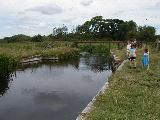 Very near the bridge is this weir pool where various Hardy characters including the mayor of Casterbridge thought of drowning themselves. Very jolly stuff, Hardy.
Very near the bridge is this weir pool where various Hardy characters including the mayor of Casterbridge thought of drowning themselves. Very jolly stuff, Hardy.

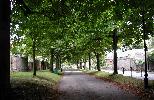
 Elizabeth-Jane first met Lucetta in this churchyard. The chestnut avenue is where Henchard and Farfrae spoke again after their estrangement. And the Barclay's Bank occupies the house thought to be the model for the mayor's own house in the novel.
Elizabeth-Jane first met Lucetta in this churchyard. The chestnut avenue is where Henchard and Farfrae spoke again after their estrangement. And the Barclay's Bank occupies the house thought to be the model for the mayor's own house in the novel.
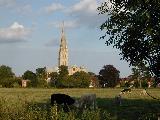
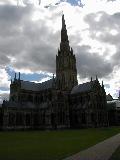 We came to Salisbury Sunday afternoon, and after confirming our lodgings we visited the cathedral and took a walk down the town path, from which the photo at left was taken in the evening. It is a bit surprising, here as at Oxford, to find pasture land so close to the heart of (and completely surrounded by) a city; but the name of the place--the water meadow--suggests adequate reason for its never having been developed. The photo on the right was taken when we returned to the cathedral next day. The huge and beautiful close-cropped lawn that surrounds the cathedral is rather surprisingly a favorite place among the local youth for sessions of intense osculation or "snogging."
We came to Salisbury Sunday afternoon, and after confirming our lodgings we visited the cathedral and took a walk down the town path, from which the photo at left was taken in the evening. It is a bit surprising, here as at Oxford, to find pasture land so close to the heart of (and completely surrounded by) a city; but the name of the place--the water meadow--suggests adequate reason for its never having been developed. The photo on the right was taken when we returned to the cathedral next day. The huge and beautiful close-cropped lawn that surrounds the cathedral is rather surprisingly a favorite place among the local youth for sessions of intense osculation or "snogging."

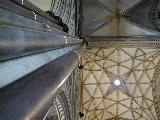 At the left you see the choir or quire, the most ornate interior space in the place, thanks to a restorative paint job as well as the usual carved wooden choir stalls (the tops of which show darkly in the foreground at bottom). In the photo at right you can see the rather alarming bend in one of the four massive marble piers that hold up the four corners of the central tower. The spire that tops the tower stabs toward heaven four hundred feet above--and only two feet and a half off center, since the great piers are more or less equally bent.
At the left you see the choir or quire, the most ornate interior space in the place, thanks to a restorative paint job as well as the usual carved wooden choir stalls (the tops of which show darkly in the foreground at bottom). In the photo at right you can see the rather alarming bend in one of the four massive marble piers that hold up the four corners of the central tower. The spire that tops the tower stabs toward heaven four hundred feet above--and only two feet and a half off center, since the great piers are more or less equally bent.
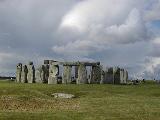
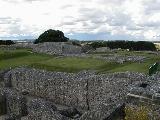 Monday morning we visited Stonehenge and Old Sarum, two sites both dating back about five thousand years as places where human effort has reshaped the landscape. Stonehenge remains a very impressive impenetrable mystery and the definitive megalithic site. I can offer no particular insight on the enduring riddle of why it was built. (It almost seems to ask that same question back at us--why were we built.) Old Sarum (right) is the site not only of a bronze-age hill fort but also of the medieval city--complete with castle and cathedral--that Salisbury was built to replace, and did replace, in the thirteenth century. The dressed stones from the surfaces of the castle walls of Old Sarum were taken for the building of the new city, leaving behind the flint-and-mortar rubble cores of the walls. Since England's unwritten constitution made no adequate provision for redistricting according to census, the place continued to be represented in parliament for more than half a millennium after being abandoned.
Monday morning we visited Stonehenge and Old Sarum, two sites both dating back about five thousand years as places where human effort has reshaped the landscape. Stonehenge remains a very impressive impenetrable mystery and the definitive megalithic site. I can offer no particular insight on the enduring riddle of why it was built. (It almost seems to ask that same question back at us--why were we built.) Old Sarum (right) is the site not only of a bronze-age hill fort but also of the medieval city--complete with castle and cathedral--that Salisbury was built to replace, and did replace, in the thirteenth century. The dressed stones from the surfaces of the castle walls of Old Sarum were taken for the building of the new city, leaving behind the flint-and-mortar rubble cores of the walls. Since England's unwritten constitution made no adequate provision for redistricting according to census, the place continued to be represented in parliament for more than half a millennium after being abandoned.
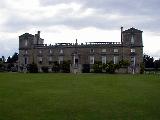
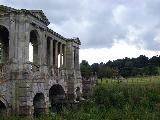 This morning we went to Wilton House, seat of the Earls of Pembroke and one of the choicer of the Stately 'Omes of England. (On the right is the celebrated eighteenth-century Palladian bridge that crosses the river just a few yards from the corner of the house.) The place used to be a monastery, but when Bluff King Hal perpetrated his dissolution of the monasteries he gave the land to a favorite henchman whom he later made First Earl of Pembroke. Such is often the root-stock of great and wealthy aristocratic families: cronies, henchmen, minions, and other kindred spirits to the various vicious pirates and gangsters who through the centuries have alternately usurped and inherited the throne of England. The Earls' family motto is "Ung Ie Serverai," archaic French for "One [only] shall I serve." This is a useful bit of ambiguity in that the "one" can be read as either king or God, as required by the vicissitudes of the times. The latter reading came in very handy during the Puritan ascendancy under Cromwell, a time when lavish ostentation was generally frowned upon but the then Earl continued to augment the sumptuousness of this house. One wonders if "Ung" was also taken to refer to God during the reigns of Hal's daughters, and Anne later on--the monarchy being a slightly less reliably patriarchal institution than the Deity.
This morning we went to Wilton House, seat of the Earls of Pembroke and one of the choicer of the Stately 'Omes of England. (On the right is the celebrated eighteenth-century Palladian bridge that crosses the river just a few yards from the corner of the house.) The place used to be a monastery, but when Bluff King Hal perpetrated his dissolution of the monasteries he gave the land to a favorite henchman whom he later made First Earl of Pembroke. Such is often the root-stock of great and wealthy aristocratic families: cronies, henchmen, minions, and other kindred spirits to the various vicious pirates and gangsters who through the centuries have alternately usurped and inherited the throne of England. The Earls' family motto is "Ung Ie Serverai," archaic French for "One [only] shall I serve." This is a useful bit of ambiguity in that the "one" can be read as either king or God, as required by the vicissitudes of the times. The latter reading came in very handy during the Puritan ascendancy under Cromwell, a time when lavish ostentation was generally frowned upon but the then Earl continued to augment the sumptuousness of this house. One wonders if "Ung" was also taken to refer to God during the reigns of Hal's daughters, and Anne later on--the monarchy being a slightly less reliably patriarchal institution than the Deity.
 Part of the park full of splendid old trees has been made into a rather splendid playground. Ariadne here comes down one of three great slides coming off a platform built high around the trunk of a vast old maple.
Part of the park full of splendid old trees has been made into a rather splendid playground. Ariadne here comes down one of three great slides coming off a platform built high around the trunk of a vast old maple.
previous entry
next entry
main/ToC page


 This bridge, Grey's Bridge, also features in the same novel, and one or two others by Hardy. A character in Under the Greenwood Tree "leant over the parapet of the bridge and looked into the river. He saw . . . the long green locks of weed that lay heaving and sinking with their roots towards the current."
This bridge, Grey's Bridge, also features in the same novel, and one or two others by Hardy. A character in Under the Greenwood Tree "leant over the parapet of the bridge and looked into the river. He saw . . . the long green locks of weed that lay heaving and sinking with their roots towards the current."
 Readers familiar with Thomas Hardy's novels, particularly The Mayor of Casterbridge, may appreciate these glimpses of Dorchester, which is thinly disguised by the name of Casterbridge in his work. Our walking tour of the Hardy sights began with St. Peter's Church and the bit of street beside it called The Bow (left), and our own hotel the King's Arms, with its bow window on what the English call the first floor and Americans call the second (right). Henchard, the novel's title character, is represented in the King's Arms on a couple of occasions in the novel (once seen through the bow window), and now the ground-floor bar is duly named Henchard's Bar.
Readers familiar with Thomas Hardy's novels, particularly The Mayor of Casterbridge, may appreciate these glimpses of Dorchester, which is thinly disguised by the name of Casterbridge in his work. Our walking tour of the Hardy sights began with St. Peter's Church and the bit of street beside it called The Bow (left), and our own hotel the King's Arms, with its bow window on what the English call the first floor and Americans call the second (right). Henchard, the novel's title character, is represented in the King's Arms on a couple of occasions in the novel (once seen through the bow window), and now the ground-floor bar is duly named Henchard's Bar.











